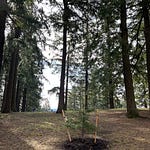Pexels—August de Richelieu
This week's action snack asks you to verbally acknowledge a structure, such as patriarchy or white supremacy, as an ultimate source of violence.
If you look around, listen to podcasts, read the news, you’ll notice many conversations about racism and sexism, often dramatized by stories about individuals, such discussions about George Floyd and the cops, or Amber Heard and Johnny Depp and whose testimony was credible and why.
You’re less likely to encounter a complex discussion of what abolitionism really means, in practice, or why a lot of people want a transformative justice approach to addressing domestic and sexual violence.
In an individualist culture—where we are daily exposed to media, movies, advertisements, and other cultural products affirming that our future, our success, is within reach and a result of our own effort and grit—it’s disheartening to be told that our ability to make change in the world is constrained by structures that predated us, and identity positions we didn’t consent to inhabit.
It’s far easier to talk about individual acts of sexism and racism than to acknowledge the power of structures like patriarchy and white supremacy. And because acknowledging the force and impact of oppression flies in the face of individualism, conversations about structures can quickly turn away from the intended subject matter and become debates about “whether it’s even realistic” to enact systems change.
You’re trying to talk about how it is that white supremacy functions, and how patriarchy is often implicated in how white supremacy categorizes and values different groups of people, and the person you’re addressing asks you if what you’re really saying is that white people are the root of injustice and do you really think all white people are the same? And . . . scene.
It’s easy to feel like the buzzkill at a party or, worse, to bear the brunt of institutional reprisal when we name entrenched systems of inequality and structural violence, instead of asking for a particular interpersonal dynamic to be adjudicated by the HR department.
This week’s challenge is to engage someone in your life in a conversation about a structure, rather than an event, or an individual act, as a source of violence. Notice I said “source,” not “cause.” When we are talking about people, we can talk about cause and effect in a linear fashion. When we are talking about structures and systems, which operate in networks, we’re addressing root sources, not linear causality. Think about a spring or a well, out of which thousands of rivers flow.
Here’s an example. There’s been lots of conversation about the #MeToo movement being at a point of “overreach.” Some of the current criticisms—too many men are being accused; it’s like the Salem witch trials; not all men are bad; how are people supposed to have sex in this environment, etc.
What’s happening in this conversation is that a focus on sexual violence has turned into a focus on individual men, and how many men out there are perpetrators of harassment and rape. The point of #MeToo is not to say that all men are rapists. The point of the movement is to transform the culture’s relationship to sexual violence so that it starts to see sexual violence as a set of behaviors that can be changed, or eliminated, rather than seen as “too big to solve.”
If we have a conversation about men as perpetrators and why men engage in sexual violence, we’ve lost the focus on the end game, which is to eliminate sexual violence. But if we start with patriarchy, the system responsible for the valuing of traits and behaviors that are coded masculine, and the devaluing of traits that are coded feminine, then we have a way of talking about the organization of the culture at large. When we talk about the kinds of masculinity that are valued in patriarchy, we see that patriarchy impacts everyone, including men, and that sexual violence is actually a logical outgrowth of patriarchy.
It’s important to remember that many of us benefit from and are oppressed by multiple structures at the same time. Please be patient with yourself if you are not used to naming structures. And please take this step in a context that can generate a conversation steeped in curiosity and engagement. The challenge here is to find words for something that is difficult to name and describe, and to receive interest and affirmation from others, when you do so.
If you recall the conversations I had with Claire about patriarchy in the last two posts, you’ll remember that we were investigating, noticing, questioning, in our discussions about how patriarchy was impacting us in the present, and how it functioned in the past. Our talks allowed us to collaborate, and in sharing our perceptions, to find more precise and powerful ways to talk about the structure that was impacting the two of us. And then Claire took our insights to Emily, so they could talk about the ways their conflict was an expression of their struggles with the patriarchal definition of “success.”
The purpose of this Action Snack is not to threaten your safety—either personally or structurally—or to generate conflict or dynamics of one-upmanship. The point is to notice how we forbid ourselves from naming root sources of violence, and as a consequence, have fewer strategies and resources available to us to fight back.
If you want to take this challenge up a rung, and you are in a position of power or authority in a group, organization, or institution, you may also want to look at the ways that organization or institution understands and explains the causes of violence that impact its members, or whether it addresses the impact of structures on its mission, vision, and values.
If you are in an environment where you are used to naming structures and participating in generative conversations about combatting structural violence, please share strategies in the comments about how you distinguish between individual acts of violence and structural oppression in conversation with others. What strategies have you and your communities used to protect individuals who name foundational structures as sources of oppression and the misuse of institutional power?
And if you are a mental health practitioner who wants to bring conversations about structural violence into your practice, but don’t quite feel comfortable with the language yet, this action snack is a perfect way to practice just naming and identifying how structures work with people in your life who are interested in these ideas.
I’d love to hear how this goes for you!













Share this post